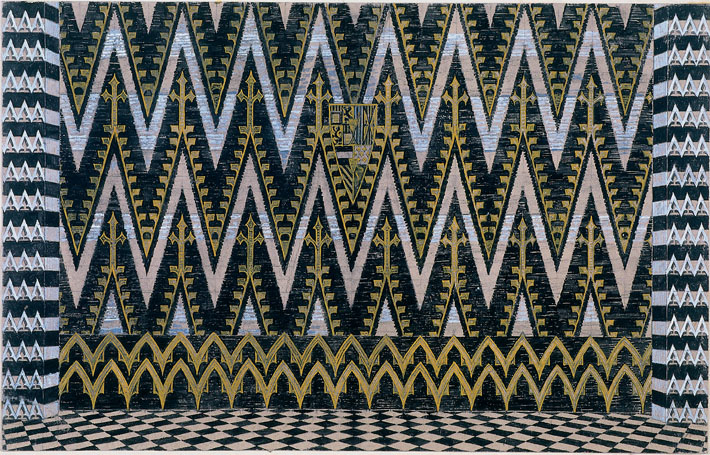One of the traits of modernization in theatre was the effort to highlight the specific characteristics of different genres of theatre. Art historian Veronika Kulešova noted in 1964 that:
[there was a] long-held opinion, formed after the war, that there was no difference between dramatic and musical theatre decorations. The specific character of the latter had been lost, despite the fact that musical theatre traditions here, like in other countries, ran quite deep. Veronikos Kulešovos kalba teatro dailės konferencijoje 1964 12 14, in: Protokolas LTSR kultūros ministerijai, 1965 01 15, p. 7.
Set designs for musical productions in the 1960s began to invoke folk traditions and interpretations of early 20th century modernism.
The early traditions of Russian abstractionist art found fertile ground in Lithuanian ballet set design. Significant changes took place on the ballet stage in the 20th century, starting with the production seasons of Sergei Diaghilev to the discovery of Kazimir Malevich's "square" and the stunning geometrical costume abstractions in Mikhail Matyushin's opera Victory Over the Sun (1913). The musical abstractionist painter Wassily Kandinsky enriched expressionism in musical productions with his combinations of contrasting colours. Fluid forms sought to embody flight and energy.
Formalist pursuits that were already being embraced in the world, yet which were unacceptable to Soviet realism, should, in theory, no longer have posed a concern for later (and certainly milder) similar experiments on Lithuanian stages. One of the few examples of set design that approximated geometric abstractionism arrived on the Lithuanian ballet stage only in 1963, created by Juozas Jankus (then already widely recognised for his work) for a production of Prokofyev's opera Love for Three Oranges. The production's set designs did not evoke any specific images. Rather, abstract geometric shapes and colour combinations were likened to music and did not represent any realistic forms.
Though the artist of early set versions, Viktorija Gatavynaitė, was accused of formalism, since her designs contained "too much abstraction," Valstybinio operos ir baleto teatro meno tarybos posėdžio protokolas, 1963 02 09, Lietuvos literatūros ir meno archyvas, f. 97, ap. 1, b. 182. the geometrically abstract set design was approved immediately. This case demonstrates the importance of an artist's recognition for the implementation of innovations, as well as the influence younger artists had on their older colleagues.
Lithuanian set designers were stunned by expressionist and surrealist experiments being conducted in musical productions in Western Europe that carried over into Polish, Czechoslovak and Russian opera and ballet. Opera in Czechoslovakia stood out for its surrealist expressionism, in which human irrationality was revealed through collage (mosaic) connections between various incompatible plot locations and objects (for example in Trester's designs for Verdi's Aida in 1957, or Paul Hindemith's opera Cardillac in 1964).
In Poland, artists freely incorporated various materials, with textures of imagery compositions woven like a collage into the structure of a production (as in Andrzej Majewski's designs for Stravinsky's ballet Orpheus in 1963). Polish and Russian set designers (Andrzej Pronaszko, Vadim Ryndin) revealed the tragic powerlessness of protagonists through expressionist, hyperbolised and associative forms.
While it may still have been impossible to employ surrealist imagery on the more publically visible and official opera and ballet stages, expressionist solutions were found that helped demonstrate that Lithuanian artists were not standing idly on the sidelines. A 1966 production of Antanas Rekašius' ballet Gęstantis kryžius (Fading Cross), with set design by the young artist Antanas Pilipavičius, stood out with its expressive, dynamic, contrastingly laconic form and intensive changes in lighting. Pilipavičius made his mark on the musical stage, helping to revive Lithuanian ballet with his innovative solutions, but he withdrew from theatrical art soon thereafter.
Artists designing sets for musical productions drew inspiration from folk art. Led by the artist Andrzej Stopka, Polish set designs began featuring multi-layered structures resembling szopkas (crèches) and simple, even primitive, costumes and motifs reminiscent of folk sculpture and architecture. Adam Killian applied folk art in a different manner, showing a fascination for the vibrant colouring of folk paintings reproduced on glass and rural materials such as wicker and straw, from which he fashioned mannequins. Modern interpretations of religious icons were created by Russian artists such as Eduard Kochergin.
The young Lithuanian set designer Dalia Mataitienė transformed music into emotional imagery through the use of folk art carvings. For a 1961 production of Yury Milyutin's operetta Chanita's Kiss, she created a fictional reality using flattened motifs arranged in thick lines and ornamental figures.




Comments
Write a comment